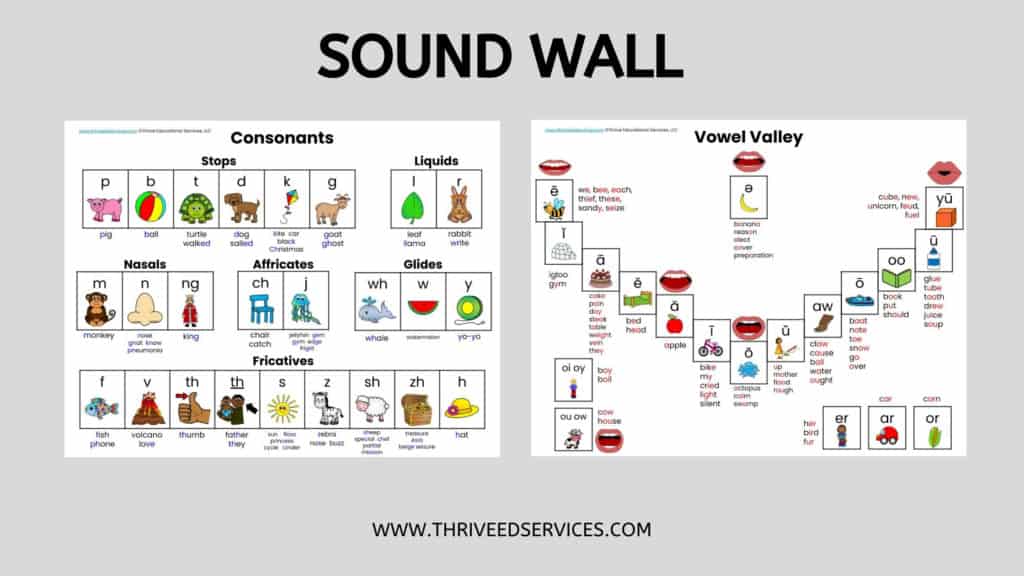Learners of English should avoid dividing words at the end of a line, especially in formal writing, such as business correspondence, resumes, examination papers, and essays. Division of words at the end of a line makes the text more difficult to read, and the divided words may look strange and may even cause wrong associations. Besides, it is very difficult to syllabify English words correctly.
Syllabification
If you need to divide a word at the end of a line, it should be done according to the rules of syllabification (also called syllabication), that is, division of words into syllables. It is best of all to use syllabification indicated in a good dictionary. If your dictionary does not show word division, consult online dictionaries, for example, Merriam-Webster Online.
Keep in mind that there are differences between British and American syllabification. Syllabification in this material is shown according to the norms of dividing words at the end of lines in American English.
Most English words are syllabified according to pronunciation: a-fraid, be-tween, lov-er, cov-er, clo-ver, i-de-a, id-i-om, ra-di-a-tor, rad-i-cal, po-ta-to, pop-u-lar, com-pat-i-ble, crim-i-nal, ta-ble.
Differences in pronunciation (stressed or unstressed syllable, shift of stress, long or short vowel sound) are reflected in numerous differences in the syllabification of words with similar spelling. Examples: fin-ish, fi-nal; fin-ger, sing-er; riv-er, fla-vor; fa-ther, moth-er; forc-ing, for-ci-ble; re-sist-i-ble, re-sis-tive; re-spon-si-ble, re-spon-sive; vis-i-ble, vi-sion; op-por-tu-ni-ty, ca-pac-i-ty, cit-y.
Many English words can be divided into syllables according to derivation, that is, between the prefix, root, and suffix (if such division does not change the pronunciation of the word): friend-ship, de-part-ment, dis-turb-ance, use-less-ness, for-get-ful, ac-count-a-ble, mis-lead-ing, aw-ful-ly, con-se-quent-ly.
Not every border between syllables is an appropriate point at which to divide a word at the end of a line. It is best of all to restructure your sentences and to do without word breaks. In the few cases where the division of a word is really necessary, use the syllabification indicated in the dictionary. Additionally, apply the rules and recommendations described below.
General rules and recommendations
Do not divide words in titles. Do not break the last word in a paragraph. Do not divide words so that the second part of the word is carried over to the next page. Try not to divide more than two or three words on one page.
Do not divide abbreviations, acronyms, e-mail addresses and URL addresses, telephone numbers, and large numbers written in figures. Avoid breaking proper names, especially people’s names and surnames. Avoid dividing short words.
The hyphen is used only after the first part of the divided word at the end of the line. If the word already has a hyphen, divide it only at the hyphen: anti-inflationary, pre-Christian, self-confident, twenty-seven.
Note:
The rules are complicated and difficult to use, except in very simple cases. The rules do not cover all possible cases of word division, and in some cases the rules are not applicable. It is sometimes necessary to apply several rules to divide a word correctly.
The hyphen in the words below indicates an appropriate place where a break between syllables can be made if you need to divide such words at the end of a line. Of course, the words below are written as single words (without a hyphen) in normal texts.
Short words should not be divided at the end of a line. Short words are given here only as examples illustrating the rules of syllabification and word division and only because I didn’t find a sufficient number of appropriate longer words at the time of writing this article.
Main rules for the division of words at the end of a line
Never divide one-syllable words, including words with the ending ED: course, source, cause, through, draught, bought; liked, burned, played, tired, mowed, drowned, grouped, stopped, watched, laughed.
Never divide words so that only one letter stands at the end or beginning of a line. Examples of two-syllable words that should not be broken: about, along, away, abridged, elect, enough, snowy, hairy, weary.
It is advisable not to leave only two letters of the word at the end of a line and not to carry over only two letters to the beginning of the next line. Try to divide so that there are minimum three letters before or after the hyphen. Examples of two-syllable and three-syllable words that should not be divided: kitchen, hobby, worker, answer, flower, retell, receive, account, affirm, inquire, belong, because, between, invite, include, painted, crowded, catches; easily, informer, video, radio, radial, menial.
Never divide vowels in diphthongs (a diphthong represents one vowel sound and forms one syllable) and never divide a vowel combination that represents one sound. Examples of words that should not be divided at the end of a line: clown, count, plough, though, load, pain, height; broom, heart, broad.
Never divide consonant combinations (and combinations of consonants with vowels) that represent one sound, such as ch, tch, dge, sh, th, ck, gh, ph, ng, gu, qu, que. Examples of division: match-ing, knowledge-able, breath-ing, pack-age, laugh-ter, daugh-ter, trium-phant, hang-ing, sing-ing, lin-guist, lin-guis-tics, lan-guage.
Divide words between the prefix and the root or between the root and the suffix if these parts consist of three or more letters and form a syllable, and if such division does not contradict the syllabification shown in the dictionary. Examples of division: com-bine, argu-ment, cour-age, law-yer, play-ful, con-sist-ing, over-whelm-ing, fan-tas-tic, pre-dict-able, for-give-ness, dis-trust-ful-ness, dis-turb-ance, mis-under-stand-ing, over-estima-tion, com-mit-ment, sub-mis-sive, super-intend-ency.
If there are several possible variants of division, divide between the root and the suffix: unpredict-able, respect-ful, educa-tional, revolu-tionary, deliver-ance, depart-ment, memoriza-tion, experi-ence, signa-ture, unselfish-ness.
If possible (if the break does not affect the pronunciation of the word), divide words after the vowel that forms a syllable alone (or with the preceding consonant) in the middle of a word. Examples of division: crimi-nal, criti-cism, prepara-tory, litera-ture, irrele-vant, signifi-cance, opportu-nity, popu-lar, popula-tion, experi-ment, experi-ence, resi-dence, coinci-dence.
The consonant letter between two vowels stays before the hyphen if the preceding vowel is short: unlim-ited, pov-erty, mod-ern. If the preceding vowel is long (or a diphthong), the consonant is carried over to the next line with the second vowel: rea-son, poi-son, fla-vor, pow-der, thou-sand.
Double consonants can be divided at the end of a line: ban-ner (but pass-er), god-dess, lit-tle, puz-zle, car-riage, hap-pen, suf-fix, get-ting, mis-sion, mes-sage, pas-sen-ger, excel-lent, incor-rect, bal-loon, hor-rible, mil-len-nium.
Two consonants between two vowels can be divided if the first consonant ends the syllable, and the second consonant begins the syllable: bor-der, lin-ger, mas-ter, blis-ter, fil-ter, bur-den, car-pet, ban-quet, wor-ship, cor-vette, recog-nize, expen-sive, collec-tive, respec-tive.
Three consonants can be divided after the first consonant if the vowel before it is short, but check the dictionary. Examples of division: chil-dren, coun-try, hun-gry, mon-grel, han-dle, han-dler, scram-ble, scram-bler, mon-ster, mon-strous, demon-strate, frus-trate. But: child-less, hand-some, monk-hood, punc-ture.
The ending ING in gerunds and present participles can be carried over to the next line in most cases: read-ing, writ-ing, divid-ing, deny-ing, judg-ing, manag-ing, notic-ing, forc-ing, turn-ing, hurt-ing, hold-ing, find-ing. If there are double consonants before ING, one of them is carried over with ING if the break does not separate the consonant from the root: split-ting, swim-ming, refer-ring. But: spell-ing, call-ing, process-ing.
If the word ends in LING, check the dictionary, as there may be surprises. Examples of division: dar-ling, duck-ling, nest-ling (noun), nes-tling (gerund or present participle, from nes-tle), han-dling, bus-tling, scram-bling, stum-bling. Note: Mute letter «t» in the verbs «nestle, bustle» and in their verbal forms «nestled, nestling; bustled, bustling».
It is advisable not to divide (that is, you should carry them over in full) the following suffixes and terminal parts of words: tion, sion, cion, gion, cial, sial, tial, cious, geous, tious, able, ible. Examples of division: condi-tion, selec-tion, exten-sion, discus-sion, suspi-cion, reli-gion, spe-cial, commer-cial, essen-tial, deli-cious, subcon-scious, gor-geous, ambi-tious, cau-tious, reli-able, accept-able, manage-able, incred-ible, resist-ible, respon-sible, incorri-gible.
Compound words should be divided between their component parts: auto-mobile, after-noon, ball-room, photo-graph, tele-vision, psycho-therapy. If a compound word has its own hyphen, divide it only at the hyphen: governor-general, great-grandfather, self-confident, nineteen-eighties.
Деление слов для переноса в конце строки
Изучающим английский язык следует избегать переноса слов в конце строки, особенно в официальных материалах, таких как деловая переписка, резюме, экзаменационные работы и сочинения. Переносы в словах затрудняют чтение, а разделённые слова могут выглядеть странно и даже могут вызвать неправильные ассоциации. Кроме того, очень трудно делить английские слова на слоги правильно.
Слогоделение
Если вам нужно разделить слово в конце строки для переноса, это следует делать согласно правилам слогоделения, то есть разделения слов на слоги (syllabification, syllabication). Лучше всего использовать деление на слоги, указанное в хорошем словаре. Если ваш словарь не показывает деление слов на слоги, обратитесь к онлайн-словарям, например, Merriam-Webster Online.
Имейте в виду, что есть различия между британским и американским слогоделением. Слогоделение в этом материале указано согласно нормам деления слов для переноса в американском английском языке.
Большинство английских слов делятся на слоги согласно произношению: a-fraid, be-tween, lov-er, cov-er, clo-ver, i-de-a, id-i-om, ra-di-a-tor, rad-i-cal, po-ta-to, pop-u-lar, com-pat-i-ble, crim-i-nal, ta-ble.
Различия в произношении (ударный или неударный слог, смещение ударения, долгий или краткий гласный звук) отражены в многочисленных различиях в слогоделении слов с похожим написанием. Примеры: fin-ish, fi-nal; fin-ger, sing-er; riv-er, fla-vor; fa-ther, moth-er; forc-ing, for-ci-ble; re-sist-i-ble, re-sis-tive; re-spon-si-ble, re-spon-sive; vis-i-ble, vi-sion; op-por-tu-ni-ty, ca-pac-i-ty, cit-y.
Многие английские слова можно разделить на слоги согласно словообразованию, то есть между приставкой, корнем и суффиксом (если такое деление не изменяет произношение слова): friend-ship, de-part-ment, dis-turb-ance, use-less-ness, for-get-ful, ac-count-a-ble, mis-lead-ing, aw-ful-ly, con-se-quent-ly.
Не каждая граница между слогами является подходящим местом, в котором можно разделить слово для переноса. Лучше всего перестроить предложения и обойтись без переносов. В тех немногих случаях, где перенос действительно необходим, используйте деление на слоги, указанное в словаре. Дополнительно примените правила и рекомендации, описанные ниже.
Общие правила и рекомендации
Не разбивайте переносом слова в заголовках. Не разбивайте последнее слово в абзаце. Не делите слова так, что вторая часть слова переносится на следующую страницу. Старайтесь не делать более двух или трёх переносов на одной странице.
Не делите сокращения, акронимы, адреса e-mail и URL-адреса, телефонные номера и большие числа, написанные цифрами. Не разбивайте переносом имена собственные, особенно имена и фамилии людей. Избегайте переносов в коротких словах.
Дефис ставится только после первой части разделённого слова в конце строки. Если в слове уже есть дефис, делите его только там, где дефис: anti-inflationary, pre-Christian, self-confident, twenty-seven.
Примечание:
Правила сложные и трудные для применения, за исключением очень простых случаев. Правила не охватывают все возможные случаи деления слов, а в некоторых случаях правила не применимы. Иногда нужно применить несколько правил, чтобы разделить слово правильно.
Дефис в словах ниже указывает подходящее место, где можно сделать разрыв между слогами, если вам нужно перенести такие слова в конце строки. Разумеется, слова ниже пишутся слитно (без дефиса) в нормальных текстах.
Не следует переносить короткие слова. Короткие слова даны здесь только как примеры, иллюстрирующие правила слогоделения и переноса, и только потому, что я не нашла достаточное количество подходящих длинных слов во время написания этой статьи.
Основные правила деления слов для переноса в конце строки
Никогда не разбивайте односложные слова, включая слова с окончанием ED: course, source, cause, through, draught, bought; liked, burned, played, tired, mowed, drowned, grouped, stopped, watched, laughed.
Никогда не делите слова таким образом, что одна буква будет стоять в конце или начале строки. Примеры двусложных слов, которые не следует разбивать переносом: about, along, away, abridged, elect, enough, snowy, hairy, weary.
Рекомендуется не оставлять в конце строки только две буквы слова и не переносить только две буквы слова в начало следующей строки. Старайтесь делить таким образом, чтобы минимум три буквы были до или после дефиса. Примеры двусложных и трёхсложных слов, которые не следует разбивать переносом: kitchen, hobby, worker, answer, flower, retell, receive, account, affirm, inquire, belong, because, between, invite, include, painted, crowded, catches; easily, informer, video, radio, radial, menial.
Никогда не разбивайте гласные в дифтонгах (дифтонг передаёт один гласный звук и образует один слог) и никогда не разбивайте сочетание гласных, которое передаёт один звук. Примеры слов, которые не следует разбивать переносом: clown, count, plough, though, load, pain, height; broom, heart, broad.
Никогда не не разбивайте сочетания согласных (и сочетания согласных с гласными), которые передают один звук, такие как ch, tch, dge, sh, th, ck, gh, ph, ng, gu, qu, que. Примеры переноса: match-ing, knowledge-able, breath-ing, pack-age, laugh-ter, daugh-ter, trium-phant, hang-ing, sing-ing, lin-guist, lin-guis-tics, lan-guage.
Делите слова для переноса между приставкой и корнем или между корнем и суффиксом, если эти части состоят из трёх или более букв и образуют слог, и если такое деление не противоречит слогоделению, указанному в словаре. Примеры переноса: com-bine, argu-ment, cour-age, law-yer, play-ful, con-sist-ing, over-whelm-ing, fan-tas-tic, pre-dict-able, for-give-ness, dis-trust-ful-ness, dis-turb-ance, mis-under-stand-ing, over-estima-tion, com-mit-ment, sub-mis-sive, super-intend-ency.
Если есть несколько возможных вариантов деления для переноса, делите между корнем и суффиксом: unpredict-able, respect-ful, educa-tional, revolu-tionary, deliver-ance, depart-ment, memoriza-tion, experi-ence, signa-ture, unselfish-ness.
Если возможно (если разрыв не повлияет на произношение слова), делите слова для переноса после гласной, которая образует слог одна (или с предшествующей согласной) в середине слова. Примеры переноса: crimi-nal, criti-cism, prepara-tory, litera-ture, irrele-vant, signifi-cance, opportu-nity, popu-lar, popula-tion, experi-ment, experi-ence, resi-dence, coinci-dence.
Согласная буква между двумя гласными остаётся перед дефисом, если предшествующий гласный звук краткий: unlim-ited, pov-erty, mod-ern. Если предшествующий гласный звук долгий (или дифтонг), согласная переносится на следующую строку со второй гласной: rea-son, poi-son, fla-vor, pow-der, thou-sand.
Удвоенные согласные можно разделить для переноса: ban-ner (но pass-er), god-dess, lit-tle, puz-zle, car-riage, hap-pen, suf-fix, get-ting, mis-sion, mes-sage, pas-sen-ger, excel-lent, incor-rect, bal-loon, hor-rible, mil-len-nium.
Две согласные между двумя гласными можно разделить, если первая согласная завершает слог, а вторая согласная начинает слог: bor-der, lin-ger, mas-ter, blis-ter, fil-ter, bur-den, car-pet, ban-quet, wor-ship, cor-vette, recog-nize, expen-sive, collec-tive, respec-tive.
Три согласные можно разделить после первой согласной, если перед ней краткий гласный звук, но проверьте в словаре. Примеры переноса: chil-dren, coun-try, hun-gry, mon-grel, han-dle, han-dler, scram-ble, scram-bler, mon-ster, mon-strous, demon-strate, frus-trate. Но: child-less, hand-some, monk-hood, punc-ture.
Окончание ING в герундии и причастии настоящего времени можно перенести на следующую строку в большинстве случаев: read-ing, writ-ing, divid-ing, deny-ing, judg-ing, manag-ing, notic-ing, turn-ing, hurt-ing, hold-ing, find-ing. Если перед ING есть двойные согласные, одна из них переносится вместе с ING, если разрыв не отделяет согласную от корня: split-ting, swim-ming, refer-ring. Но: spell-ing, call-ing, process-ing.
Если слово оканчивается на LING, проверьте в словаре, т.к. могут быть сюрпризы. Примеры переноса: dar-ling, duck-ling, nest-ling (сущ.), nes-tling (герундий или причастие, от nes-tle), han-dling, bus-tling, scram-bling, stum-bling. Примечание: Немая буква «t» в глаголах «nestle, bustle» и в их глагольных формах «nestled, nestling; bustled, bustling».
Не следует делить на части (то есть нужно переносить целиком) следующие суффиксы и конечные части слов: tion, sion, cion, gion, cial, sial, tial, cious, geous, tious, able, ible. Примеры переноса: condi-tion, selec-tion, exten-sion, discus-sion, suspi-cion, reli-gion, spe-cial, commer-cial, essen-tial, deli-cious, subcon-scious, gor-geous, ambi-tious, cau-tious, reli-able, accept-able, manage-able, incred-ible, resist-ible, respon-sible, incorri-gible.
Сложные слова следует делить между их составными частями: auto-mobile, after-noon, ball-room, photo-graph, tele-vision, psycho-therapy. Если в сложном слове есть свой дефис, делите слово при переносе только там, где дефис: governor-general, great-grandfather, self-confident, nineteen-eighties.
Are you confused about how to divide words into syllables? Or maybe you’re not sure exactly how to teach your students the syllable division rules. It can be tricky, but with a few simple rules, you’ll be able to do it like a pro. In this blog post, we will discuss the most common ways to divide words into syllables, as well as provide some tips for making the process easier. So if you’re ready to learn more about breaking words into syllables, keep reading!
Why Syllable Division Is Helpful
By knowing how to split words into syllables, students can chunk up bigger words into more manageable pieces. This helps them read longer and more difficult words, as well as unfamiliar words.
Dividing words into syllables also helps you figure out what the vowel sound will be. When students come across unfamiliar words, breaking them up into syllables can help them predict what the vowel sound will be based on the patterns they see in the words.
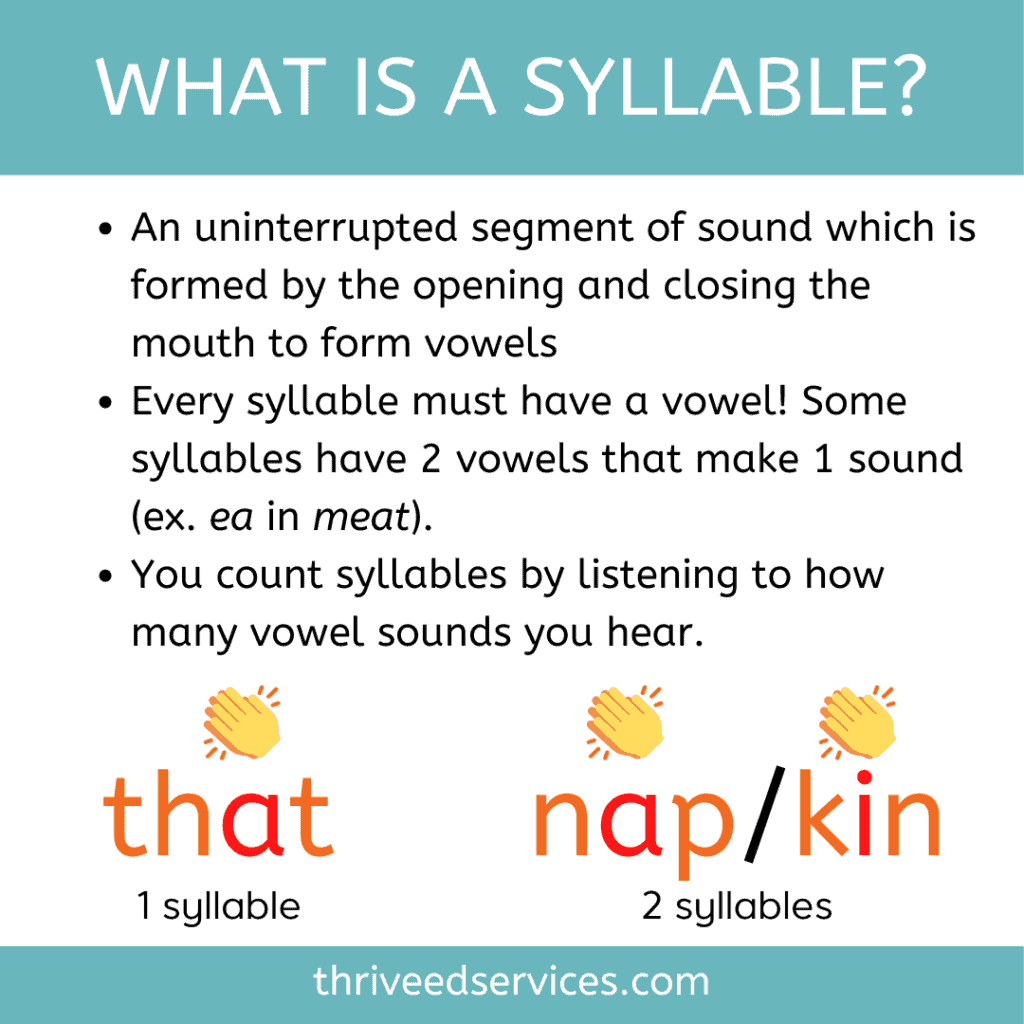
Syllabication Rules
There are several rules, or better yet patterns since there are always some exceptions, that can help with syllable division. Remember that there are 6 syllable types, but some words are only 1 syllable. Refer to my guide on the 6 syllable types for more on each.
The main thing to keep in mind when dividing words into syllables is that every syllable must have a vowel sound! We hear a vowel sound in every syllable, and sometimes it takes more than one vowel to make a vowel sound.
Here are the different rules to break words into syllables:
Rule 1: VC/CV – Split 2 consonants that are between vowels.
Whenever 2 consonants come together in a word, divide between them: VC/CV
The exceptions to this are to keep consonant digraphs (i.e. ch, ph, ck) and consonant blends (i.e. bl, st, fr) together.

Check out my VCCV Syllable Division Worksheets if you’re looking for a ready made teaching resource.
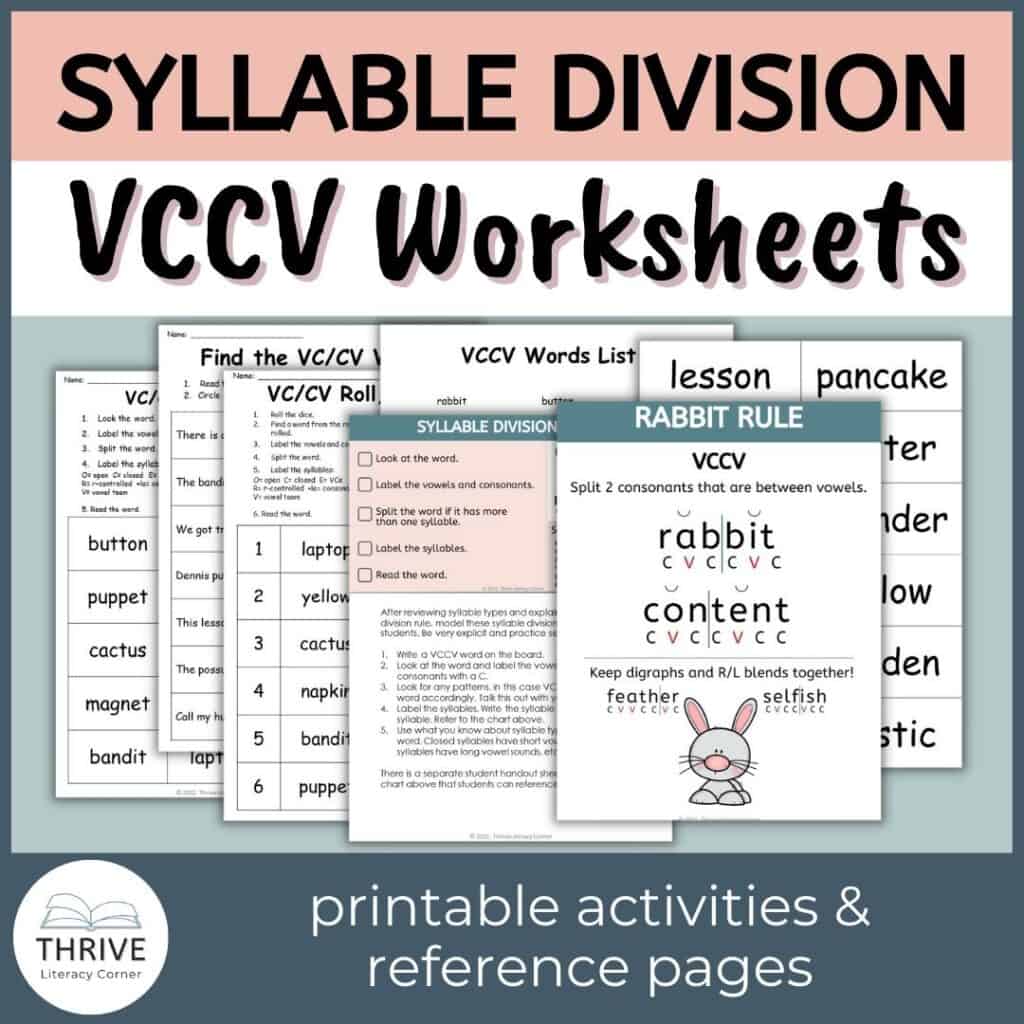
Rule 2: C+le – The ending -le usually takes the consonant before it to make one syllable.
When a word ends with a consonant and -le, divide it before the consonant so that the last syllable is C+le.
The silent e in C+le words helps add that vowel sound we need in every consonant. It’s one of the many jobs of silent e.
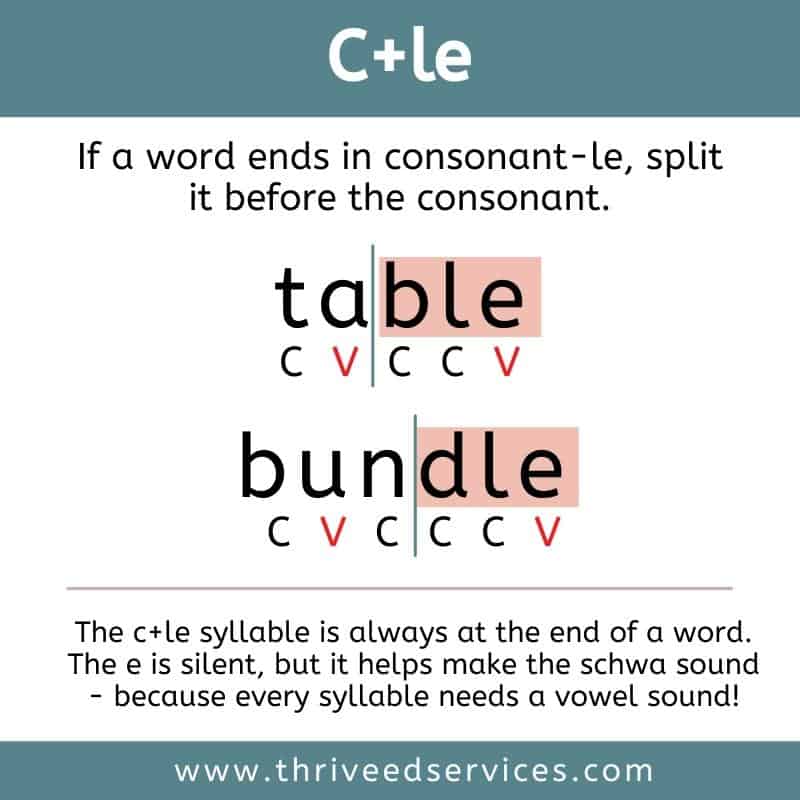
Check out my C+le Syllable Division Worksheets if you’re looking for a ready made teaching resource.

Rule 3: V/CV & VC/V – Split before or after a consonant that comes between 2 vowels.
When only one consonant comes between vowels, divide after the first vowel: V/CV. This makes the first syllable an open syllable, and it will have a long sound.
Pronounce the word with an open syllable. If this doesn’t make a word that sounds familiar, then divide after the consonant: VC/V. This makes the first syllable closed, so the vowel will say its short sound.
Because this one is not as predictable I teach it after VCCV and C+le. I typically start with V/CV only, then I teach VC/V. After this, I mix them up and teach students to be flexible, showing them how to try it as V/Cv first, then VC/V after.
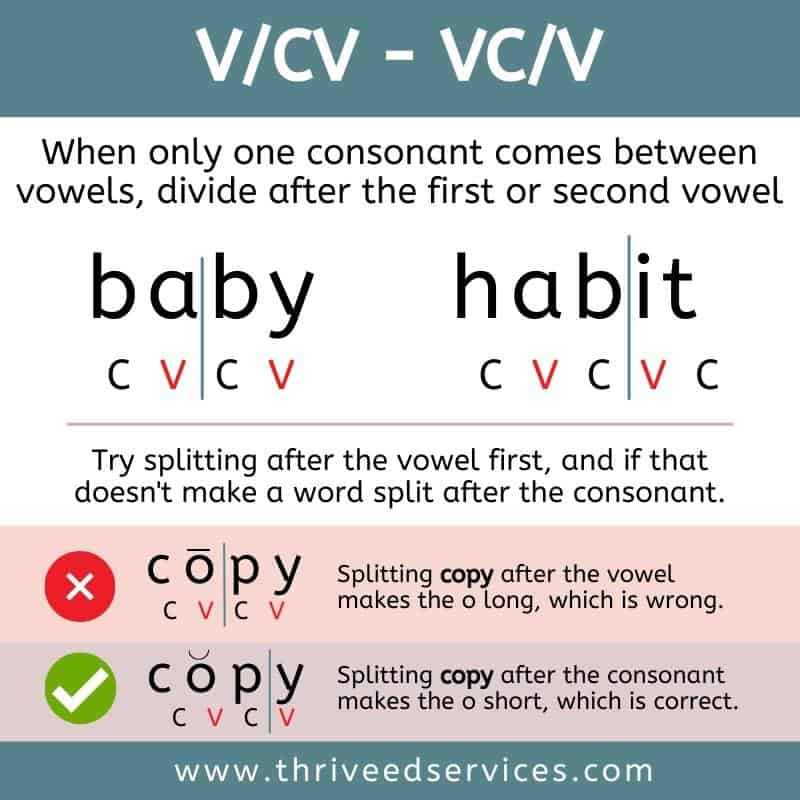
Check out my VC-V and V-CV syllable division worksheets if you’re looking for ready made teaching resources.
Rule 4: V/V – Split 2 vowels next to each other that do not work as a team.
If a vowel combination is in reverse, divide between the vowels: V/V. In this case, each vowel will have a sound.
It’s so important for students to know common vowel teams so they don’t split those up! If students are still learning basic vowel teams, wait to teach this syllable division pattern. Words like “beach” and “boat” have vowel teams that do not get split. These vowel teams work together to represent one vowel sound.

Rule 5: VC/CCV & VCC/CV – Split before or after the second consonant when 3 consonants come together.
When three consonants come together, divide after the first consonant: VC/CCV. If this doesn’t make a word that sounds familiar, divide after the second constant: VCC/CV.
These words often contain blends and digraphs, which if you recall, do not get broken up. When you see 3 or more consonants together, look for blends and digraphs to help determine where to split the word.
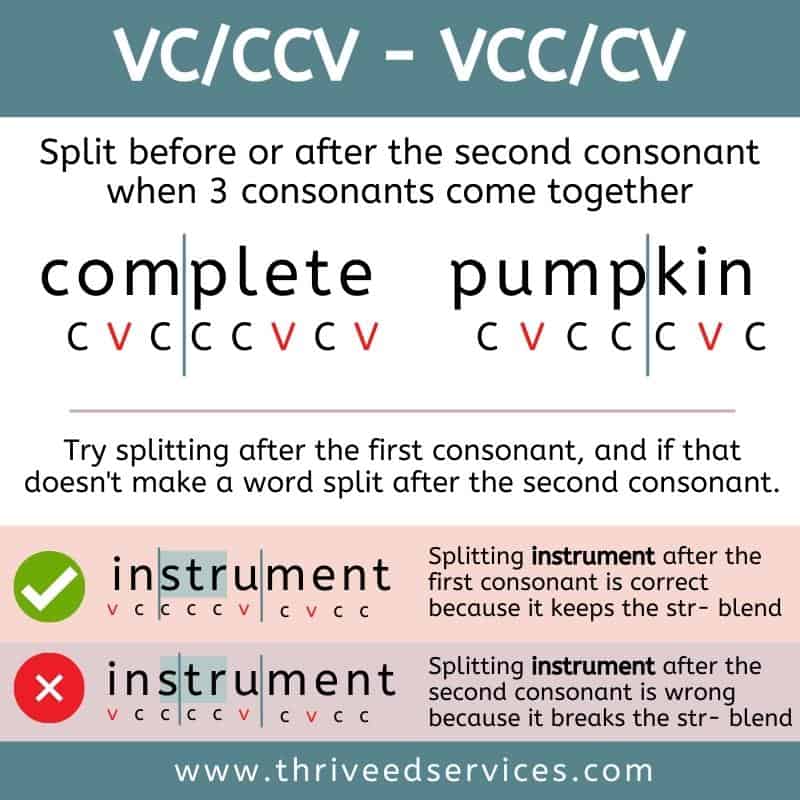
Rule 6: Divide after a prefix and before a suffix.
When you see a prefix, divide the word right after it. When you see a suffix, divide right before it. There are a few exceptions to suffixes creating their own syllable, but this will be apparent after the student has split up the word and tried to pronounce it.
The exception to this rule is the suffix -ed. Sometimes this does not create an extra vowel sound, such as in the words jumped and sailed. Regardless, once the suffix is identified and the word is pronounced, you’ll know if it’s a syllable or not.
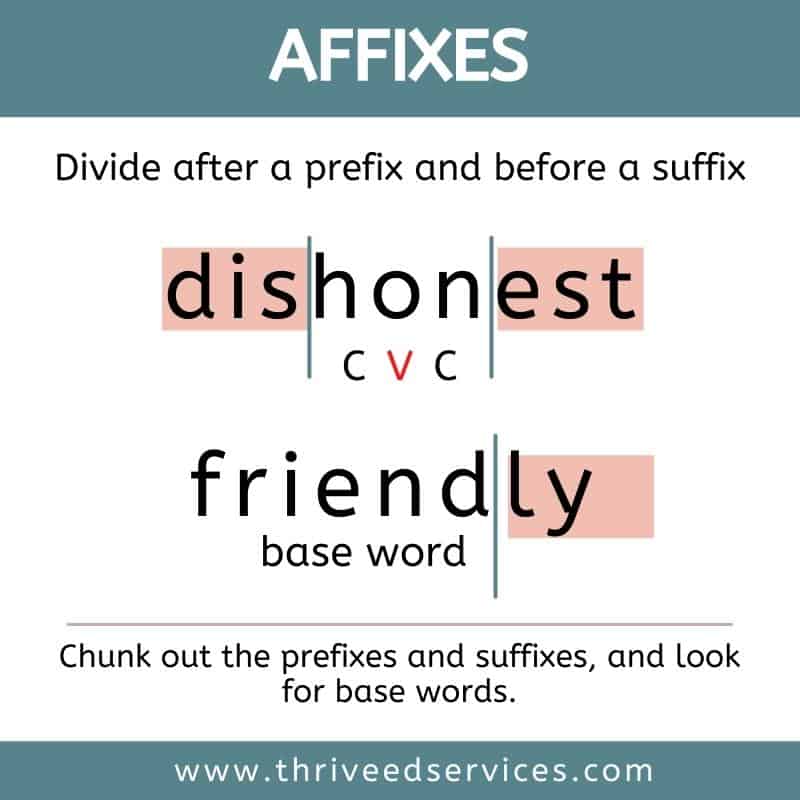
Strategies To Teach Syllabication Rules
Teach students to use vowels to identify syllables
Since one vowel sound = one syllable, the first thing students should do is identify the vowels. I always have my students draw a dot above each vowel. After that, I have them label every vowel and consonant by writing a V or C under each letter. Then they have to check if it’s a vowel team or silent e. At this point, they know exactly how many syllables a word has, even if they’re not sure where to split it yet.
Below is an example using the word student.

Teach students to look for patterns
At this point, students can look for patterns in the consonant and vowels. Students should look for vowel teams and magic e’s, digraphs and blends, then look for syllable patterns: VC, CV, VCCV, VCe, C+le, VCV, VV, Vr.
Teach base word families, prefixes, and suffixes
Students should also check for any base words, prefixes, and/or suffixes. Each base word or affix usually is its own syllable, but in some cases, they are not. Students can split these and try reading the word.
Teaching affixes daily and working with word family groups is a great way to address this area. Through consistent exposure and practice, students internalize these word parts and more quickly divide words into syllables.
Teach the different spelling patterns for each sound
It’s helpful if students know the options for spelling certain sounds, such as all the ways to pronounce the suffix -ed. This way when they are breaking up the word into syllable and sounding it out, they can accurately read a word.
A sound wall is a great way to teach all the spelling patterns for each sound. You can display each spelling pattern as students learn it and keep it up all year long as a reference. Read more about sound walls here.
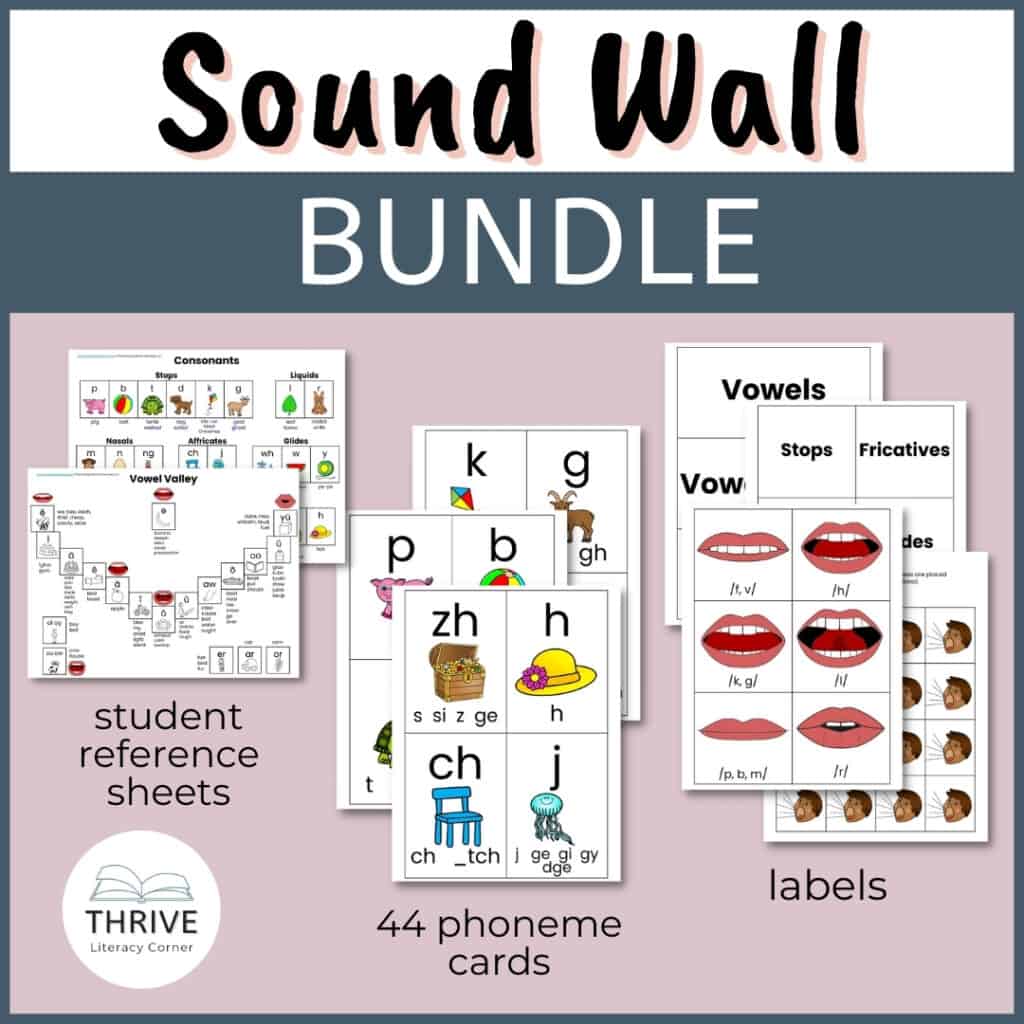
Syllable Activities For Teaching Syllable Separation
Start off with teaching the 6 syllable types, one at a time. I created a bundle of all my syllable division worksheets which you can check out below.

You can also download these syllable types reference posters by signing up for my email list below.

Diagram multisyllabic words
Whenever I am teaching syllabication, students must always follow the same procedure to diagram each word:
- Spot and dot the vowels
- Label the consonants and vowels underneath
- Look for patterns, affixes, and base words
- Split according to the rules
- Mark the vowels as long or short
- Read the word aloud
Below is an example, the same picture I used above to show how to mark the vowels. You can see the student placed a dot above both vowels, labeled each consonant and vowel, found blends, found where to split the word, then marked the vowels as long and short.

Cut words into syllables
The very first activity after teaching the syllable division pattern is to cut words up because the visual really helps struggling learners. I write a few words on index cards, have students diagram the words, then cut them along the division line. We later use these to sort syllables.
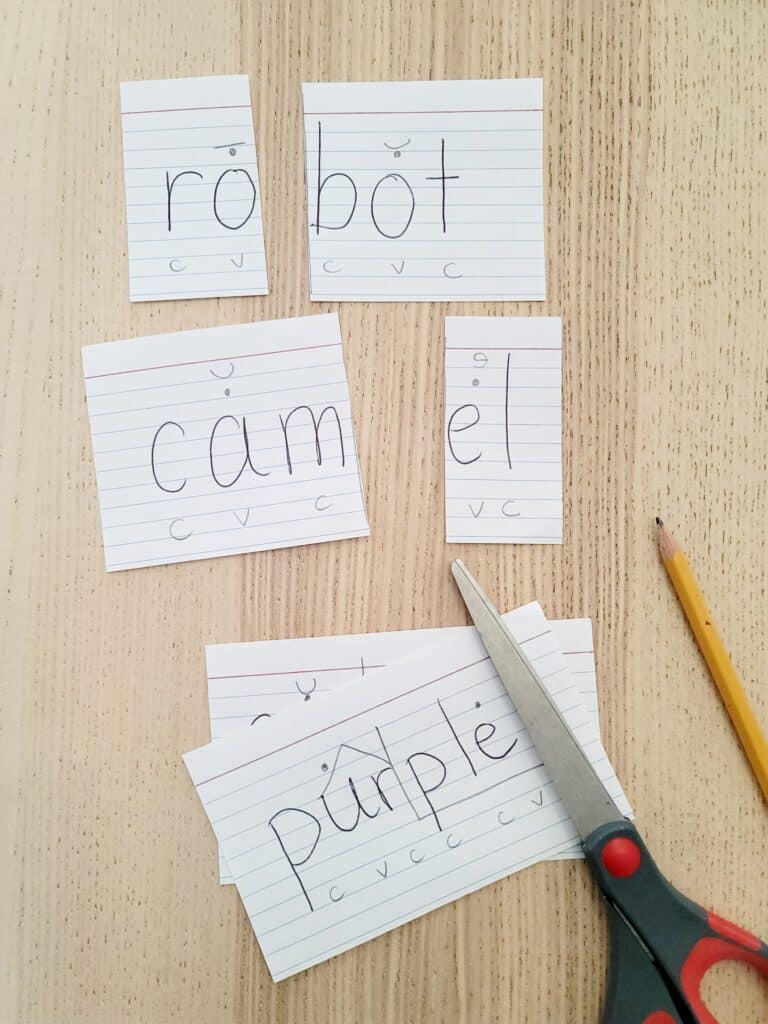
Sort syllables
There are tons of syllable sorting activities you can download and prepare, but I like to use the cut up syllables from the previous activity to sort syllables. You can sort into all the syllables types or just choose 2 to focus on as pictured below.

I also use a syllable and vowel pattern chart to sort syllables as I teach them. Each student has their own copy of this and fills it in as we learn each syllable.
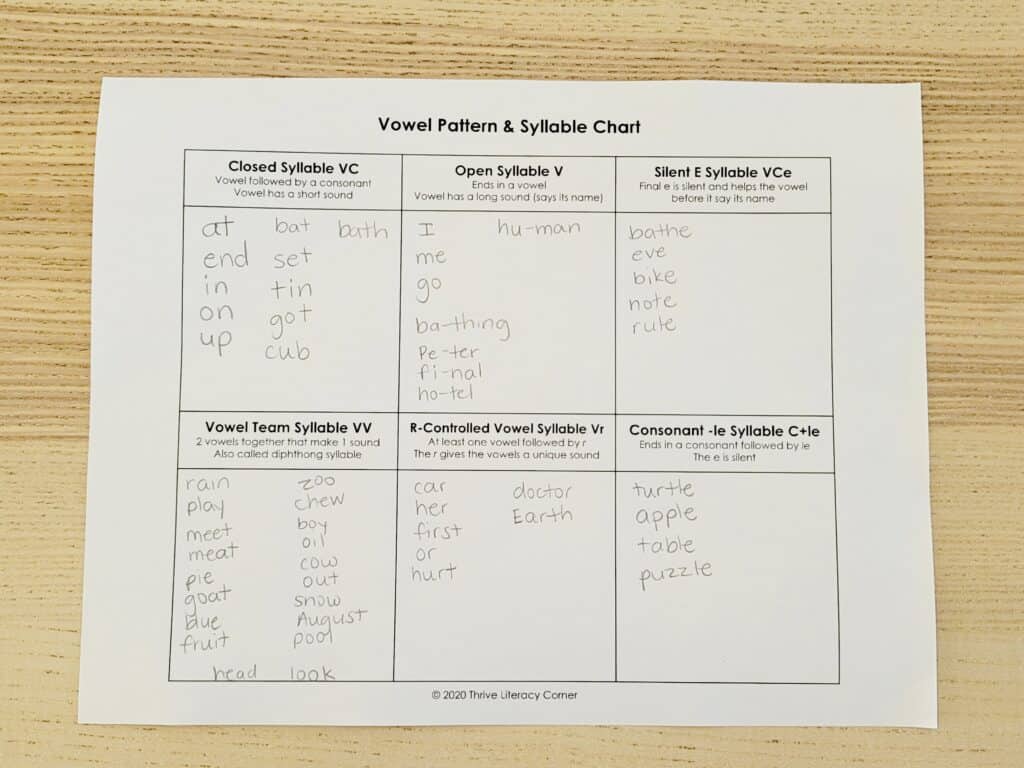
Syllable search
This is an easy activity you can do with any text, but a targeted decodable text is ideal. Simply ask students to read a passage and highlight all the words that have the target syllable. From here, students can create a list of the words they found and split them.
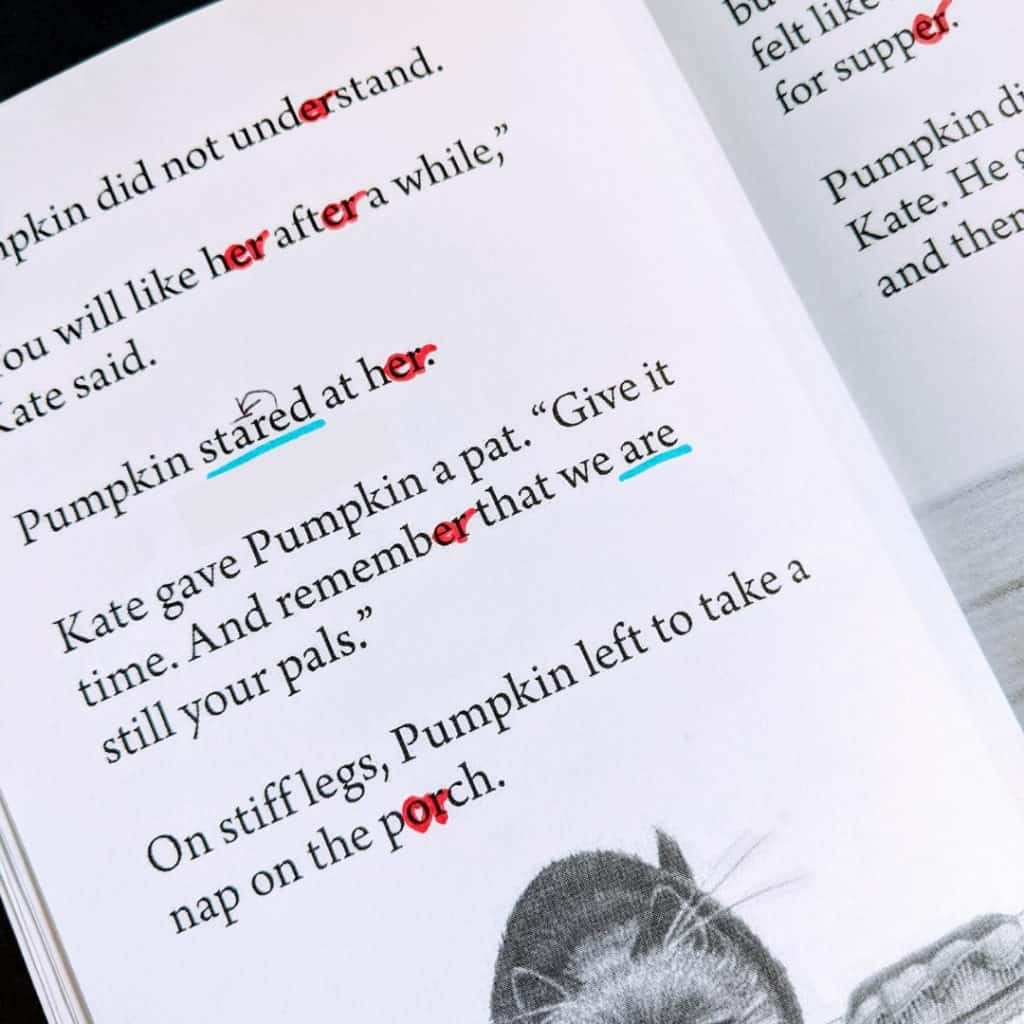
Conclusion
Syllable division rules help readers break words into smaller parts making reading the word easier on their brains. This means that they don’t have to work as hard when trying to figure out what word you’re saying or spelling because each syllable has its own meaning and breaks up the task of decoding letters in order one at a time for your brain. Try these activities next time you teach syllable division.
Sources:
- How To Teach Spelling by Laura Toby Rudginsky and Elizabeth C. Haskell
- Phonics and Spelling Through Phoneme-Grapheme Mapping by Katheryn E. S. Grace
- Structured Literacy Interventions: Teaching Students with Reading Difficulties, Grades K-6 by Louise Spear-Swerling
- Speech to Print: Language Essentials for Teachers by Louisa Cook Moats
Want to remember this? Save Syllable Division Rules: How To Divide Words Into Syllables to your favorite Pinterest board!
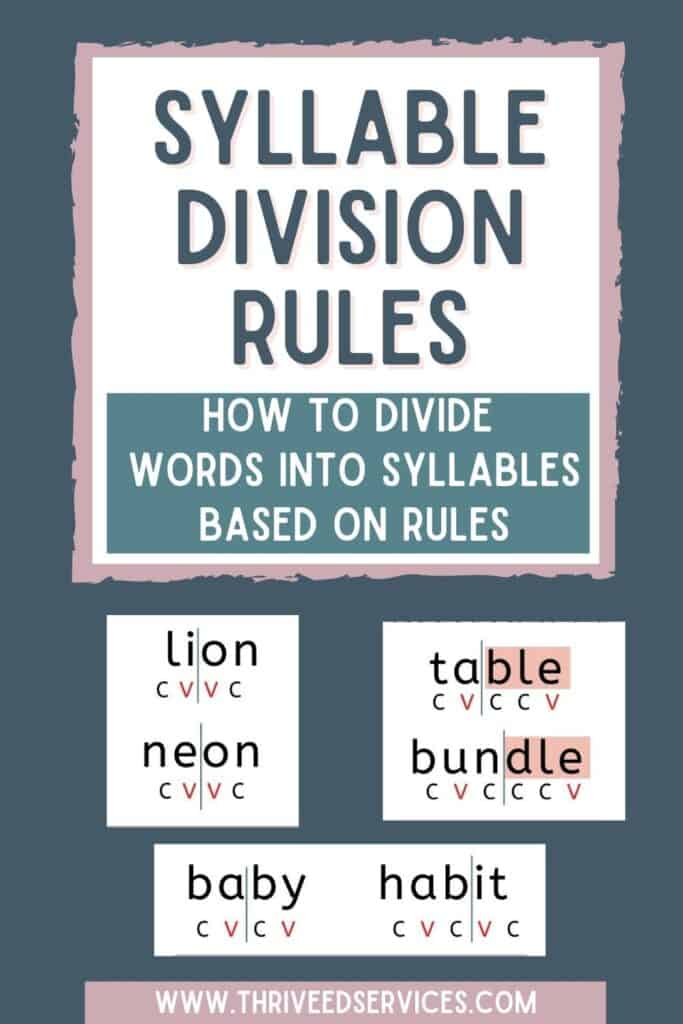
Delilah Orpi is the founder of Thrive Literacy Corner. She has a Bachelor’s degree in Special Education, a Master’s degree in TESOL, and is a member of the International Dyslexia Association. She is an experienced educator and literacy specialist trained in Orton Gillingham and Lindamood Bell. Delilah creates literacy resources for educators and parents and writes to create awareness about dyslexia and effective literacy instruction based on the science of reading.
Like spelling rules, the rules for word division may seem arbitrary. Actually, they follow specific guidelines. The following rules explain the basics of properly dividing words. A good dictionary is the best guide for divid- ing words correctly.
General Rules
Following are two general rules for word division.
1. Avoid dividing words at the end of more than three successive lines.
| AVOID | BETTER |
|---|---|
| We came into the confer- ence hall late but man- aged to find our seat- ing arrangements before the first speaker began. |
We came into the confer- ence hall late but man- aged to find our seating arrangements before the first speaker began. |
2. Avoid dividing a word at the end of a page or dividing the last word of a paragraph.
Syllables and Word Division
Words are divided only between syllables. As a result, one-syllable words such as trough, while, and there are never divided.
Each syllable in word division must contain a vowel; therefore, most contractions cannot be divided.
- con-trol (not con-tr-ol)
- couldn’t (not could-n’t)
- hy-drau-lic (not hy-dr-au-lic)
- isn’t (not is-n’t)
When a word is divided, there must be more than one letter on the first line and more than two letters on the second line.
| INCORRECT | CORRECT |
|---|---|
| He apologized to everyone most sincere- ly. |
He apologized to everyone most sin- cerely. |
| She told reporters that all her jewel- ry had been stolen. |
She told reporters that all her jew- elry had been stolen. |
| “Look at this letter; it’s full of e- rasures.” |
“Look at this letter; it’s full of era- sures.” |
| He’s not sick. He’s suffering from a- pathy. |
He’s not sick. He’s suffering from ap- athy. |
Single-Letter Syllables
A single-letter syllable will always be a vowel. Generally, a single-letter syl- lable within a word should be left with the first part of the word and not carried over to the second line.
- bus-i-ness = busi-ness (not bus-iness)
- ox-y-gen = oxy-gen (not ox-ygen)
- sep-a-rate = sepa-rate (not sep-arate)
When two single-letter syllables occur together in a word, divide the word between the single-letter syllables.
- grad-u-a-tion = gradu-ation (not grad-uation)
- in-sin-u-a-tion = insinu-ation (not insin-uation)
When the single-letter syllable a, i, or u is followed by the final syllable ble, bly, or cal, join the two end syllables and carry them over to the next line.
- cler-i-cal = cler-ical (not cleri-cal)
- de-pend-a-ble = depend-able (not dependa-ble)
Final and Double Consonants
If a final consonant preceded by a vowel is doubled before adding a suffix, divide the word between the two consonants.
- plan + ing = planning = plan-ning
- set + ing = setting = set-ting
- win + ing = winning = win-ning
If the root word ends in a double consonant before the suffix is added, divide the word between the root word and the suffix.
- assess + ing = assessing = assess-ing
- tell + ing = telling = tell-ing
A word should never be divided between two or three consonants pro- nounced as one.
- catch-ing (not cat-ching)
- cush-ion (not cus-hion)
- leath-ery (not leat-hery)
Hyphenated Words
Divide hyphenated words and compound hyphenated words only at the hyphen that connects them.
- self-assessment = self-assessment (not self-assess-ment)
- ex-husband = ex-husband (not ex-hus-band)
- client-oriented approach = client-oriented approach (not client-or-iented approach)
Proper Names
Avoid dividing a person’s name or any proper name. Separate titles, initials, or degrees from names only when it is unavoidable.
| AVOID | BETTER |
|---|---|
| Mrs. Joan Cunning- ham |
Mrs. Joan Cunningham |
| Ms. Angela Sortino |
Ms. Angela Sortino |
| George Watson, PhD |
George Watson, PhD |
Figures and Abbreviations
In general, avoid dividing figures and abbreviations. However, if parts of an address or date must be separated, use the following guidelines.
Dividing Addresses
| AVOID | BETTER |
|---|---|
| 15 Water Street |
15 Water Street |
| 557 West Lock- port |
557 West Lockport |
| 1903 71st Avenue |
1903 71st Avenue |
| New York, New York |
New York, New York |
Dividing Dates
| AVOID | BETTER |
|---|---|
| August 20, 1976 |
August 20, 1976 |
| September 15, 19- 55 |
September 15, 1955 |
| 1903 71st Avenue |
1903 71st Avenue |
| New York, New York |
New York, New York |
If a
syllable is a sequence of sounds, then one sound is usually in
stronger position and is better heard. This sound is called
syllabic.
Syllabic sounds in English language are
vowels
(monophthongs and diphthongs) and
sonants.
Thus, syllable formation in English is based on the opposition
vowelsconsonant.
Consonants are not syllabic.
A sonant becomes syllabic if
it is preceded by a noise consonant. Syllabic sonants are considered
to be – [l], [n], and less often [m].
In the
following words sonants are syllabic: [sΛdn], [dΛznt], [rΛ∫n].
And in the following words they are not syllabic: [sænd], [dəunt
du].
If the word
is pronounced with a neutral sound before a sonant, the latter loses
its syllabic function: as in words
[sΛdən],[RΛ∫ən].
In the
English language sonants
w
and
j
are never syllabic. It may be explained by their position in a word
(usually initial).
Each
syllable has its own, certain structure which depends on a sound that
occurs in the final position. Structures of a syllable can vary due
to the amount and the arrangement of consonants. Taking this into
account we may differentiate two basic types of a syllable: open and
closed. The first ends with a vowel sound like in the words
writer, he, they;
and the second ends with the consonant as in words
it, without, hundred.
In English
there are distinguished 4 basic types of syllables. If we take
C
– for a consonant and
V
– for a vowel, the structure of a syllable can be displayed in a
plenty of combinations.
—
completely open syllables consisting only from one vowel — V
([o:],[ai])
—
completely closed syllables CVC, CVCC, CCVC:
bit, left, pleis;
— the
syllables covered at the beginning: CV (nou), CCV, CCCV —
too,
spy, straw, note.
— the
syllables covered at the end: VC, VCC, VCCC —
on,
act, acts, oh, oak.
Thus, all types of syllables
can be united in one scheme in the following way — (C) V (C) where
brackets show optional presence of a consonant.
Speaking about the structure
of the English syllable, it is necessary to mention, that the one
deals with the phonetic syllables, i.e. with the syllables consisting
of actual sounds of speech. And we should not confuse them with the
open and closed syllables, used in the rules of reading.
Also it is
necessary to note, that in the English language the basis type of a
syllable is a closed one.
(while in Russian open)
The amount of consonants in prevocalic positions, i.e. in a position
preceding the vowel, can reach 3, and in a postvocalic position, i.e.
after a vowel — 5. The number of syllable varieties is 23. The number
of syllables in the English word may vary from 1 to 8. For example,
Come, city, family,
simplicity, unnaturally, incompatibility, unintelligibility.
II. Syllable division.
Syllable division is very
closely connected with syllable formation
Syllable division is marked by
an increase of muscular tension and greater force of an exhalation.
Syllable
division
in
various languages has the linguistic importance as it enables to
create typology of syllables and syllabic structure of significant
units of language, i.e. morphemes and phonemes.
Syllable division determines
syllabic structure of a language, its syllabic typology. The science
which is engaged in the problems of the syllable division is called
phonotactics.
Correct
syllable division is very important because closely connected with
pronunciation and thus with understanding. Wrong division of words
into syllables can result in phonological mistakes and as a result
will lead to misunderstanding. Compare:
a name — an aim; a nice house — an ice house; she saw the meet — she
saw them eat.
It
is easy to
understand that syllabic structure of a language, as well as its
phonemic system, is patterned. It means, that sounds in a language
are grouped in syllables according to certain rules.
As phoneticians specify, the
problem of syllable division in English exists only in the case, when
consonants (or the combination of consonants) is in intervocalic
position as in words city, agree, extra …
In such cases the point of
syllable division is not easily found.
Some phoneticians claim, that
the border of a syllable passes right after the intervocalic
consonant, while the others insist, that it goes directly through the
consonant. In both cases the syllable remains closed according to the
rules of phonotactics. The instrumental analyses showed, that the
border of a syllable in such words as pity, topic, measure, Bobby.
i.e. (C) VCV (C) type, passes directly through the consonant.
Syllable
division of English
words is based on the following rules.
-
the intervocalic consonant
tends to join the following syllabic sound if it is preceded by a
diphthong, long vowel or a short unchecked vowel. The boundary goes
immediately after the vowel Like in words: Betty, hotter, money
Here some peculiarities or
different points of view should be taken into account.
-
the
intervocalic consonant can belong to the short vowel preceding it
(pity,
cofi,
beter) -
the
intervocalic consonant can belong to the short vowel following it
piti,
cofi,
beter -
syllable
boundary goes through the consonant ( in this case both consonant
sounds structurally belong to preceding and flowing vowels) .
2. A short
stressed vowel separated from another syllabic sound only by one
consonant is considered to form a closed syllable a syllable boundary
being within the consonant: meni,
spanish,
bodi,
etc.
Now
we shall proceed directly to the function of the English syllable of
which we may count 2.
Well,
English syllable possesses two basic functions.
The First function is
constitutive function. It lies in its
ability to be a part of a word or a word itself. As the syllable
forms language units of a higher rank (morphemes, words).
The Second
important function of a syllable – is distinctive.
I.e. syllables can distinguish words and word forms. Compare:
Nitrate
— night rate, an aim — a name, mice kill — my skill, peace talks —
pea stalks, I saw her eyes — I saw her rise.
Summarizing
the whole idea, I would to once again mention, that the syllable can
be viewed as the smallest pronounceable unit of a certain linguistic
importance.
Соседние файлы в предмете [НЕСОРТИРОВАННОЕ]
- #
- #
- #
- #
- #
- #
- #
- #
- #
- #
- #
English Review of Word Division
https://schooltutoring.com/help/wp-content/themes/movedo/images/empty/thumbnail.jpg
150
150
Deborah
Deborah
https://secure.gravatar.com/avatar/63fb4ad5c163b8f83de2f54371b9e040?s=96&d=mm&r=g
June 14, 2016
June 14, 2016
Overview
Although it is always better to avoid dividing words, English has rules about dividing words by syllables if necessary. Words of one syllable cannot be divided. Words are often divided using prefixes, suffixes, and syllables.
Words Not to Divide
It is always better to avoid dividing words, because when part of a word is on one line and the rest of the word is on another line, it makes the word harder to read. In formal writing, such as business letters, essays, and resumes, words are not divided to avoid misunderstanding. Words of one syllable, such as through, friend, and stopped, are never divided. Similarly, words on more than one syllable are not divided if it would result in just one or two letters on a line, such as radio, omit, about, elect, and enough. Titles, acronyms, abbreviations, and proper names are not divided.
Words of More than One Syllable
Words of more than one syllable are divided at the syllable, unless the division results in just one or two letters on a line, such as Eng-lish for English, and pave-ment for pavement. The hyphen is with the first part of the word if the word is at the end of the line. For example, if the word were coercion, it would divide as coer- on one line and then cion on the other line.
Prefixes and Suffixes
Whenever possible, divide words so that the prefix is separated from the stem of the word or the suffix is separated from the stem of the word, such as mis-pronounce, sub-sidize, hop-ing, or dear-est. Do not divide suffixes such as cion in coercion, cial in special, tion in administra-tion, or gious in conta-gious. Words such as consider-able, prefer-ence, and crea-tive can be divided that way. Always consult a dictionary when in doubt.
Double Consonants
Words are often divided between double consonants, such as ban-ner, puz-zle, hun-gry, and forgot-ten. However, if the stem ends in a double consonant, the word is not divided between them, such as assess-ment, bill-ing, and full-est.
Interested in English tutoring services? Learn more about how we are assisting thousands of students each academic year.
SchoolTutoring Academy is the premier educational services company for K-12 and college students. We offer tutoring programs for students in K-12, AP classes, and college. To learn more about how we help parents and students in Greenville, NC visit: Tutoring in Greenville, NC

